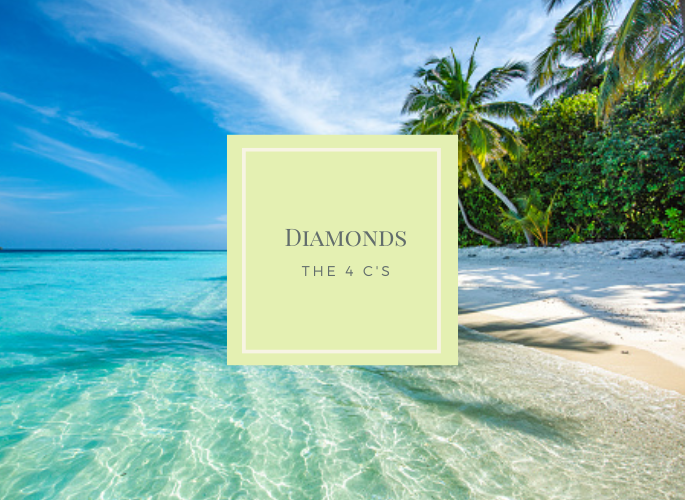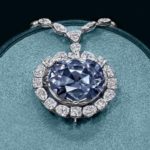Diamond cutting, shaping, and setting into jewelry has been around since ancient times. Cutting diamonds dates back to as early as the 14th century in India. Thanks to technological advances made throughout history, the rare stone is rendered to be of higher quality and value. Even today, the process of transforming a single, raw diamond into a beautifully-cut gem can take up to a month or more! During that process the 4 Cs are defined and determined: Cut, Color, Clarity, and Carat-Weight. Therefore, you may look at two diamonds and think they’re identical, but can in fact have very different cuts, colors, clarities, and carats. The different combinations of the 4 Cs are what determine the quality and value. While many clients tend to focus on carat, less-weight, yet high-quality diamonds can add great value to the piece. When you’re shopping for diamonds, ask to know about its characteristics.
1. Cut
This concept is probably the most complicated to grasp, partly because the word “cut” is used to describe the shape of a diamond as well as its cut, which are two different things. For example, you can have a pear-cut diamond that refers really to a pear-shaped diamond, but that diamond is cut in a, for instance, brilliant cut or a rose cut.
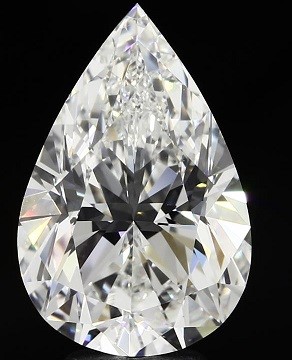

When diamonds are cut to good proportions, they are better able to handle light. Light is reflected from one facet (flat area of a diamond) to another and then dispersed through the top of the stone. If the cut of the diamond is too deep, some light escapes through the opposite side of the pavilion. Since cut determines how much a diamond sparkles, many experts believe it to be the most important of the Cs. Cut creates how the light will reflect and refract, thus there are three additional sub-characteristics: brilliance, fire, and scintillation. When you see internal and external white light reflected from a diamond, you’re noticing “brightness.” If you see the scattering of light into all the colors of the rainbow, you’re being treated to “fire.” Sparkle is actually “scintillation,” the pattern of bright and dark areas caused by reflections within the diamond as it or the light source moves. What you might consider “sparkle” is really the overall visual effect of these three factors. In summary, if a diamond has an excellent cut it will sparkle marvelously. If the contrary, the diamond will appear dark and dull.
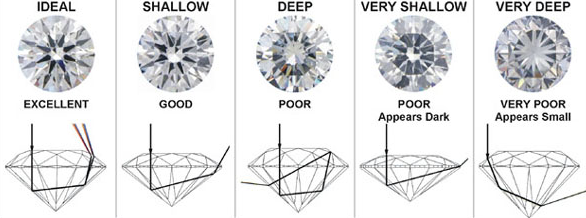
As mentioned before, cut is also used to describe the shape of a diamond. There are a myriad of diamond shapes to choose from, but some of the most popular ones are the round, marquise, pear, emerald, oval, and heart.
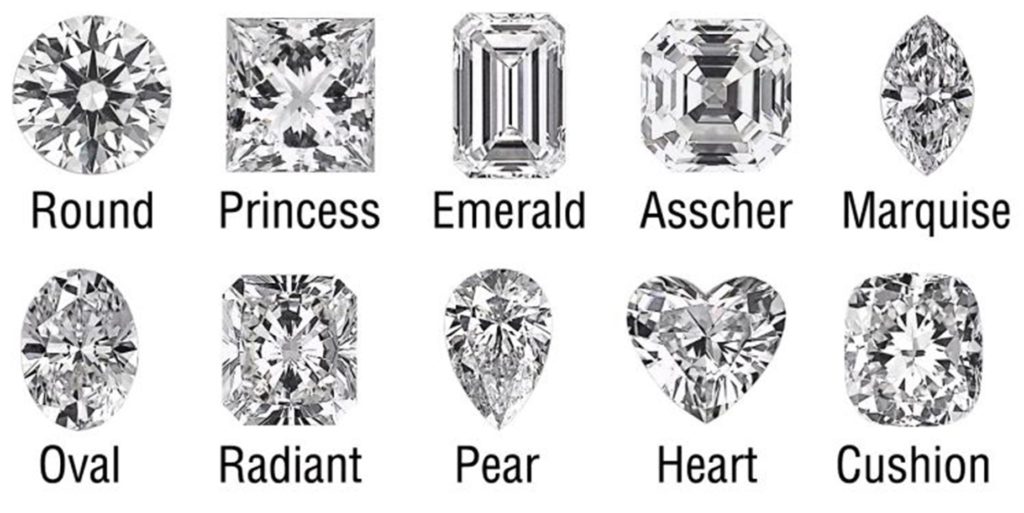
2. Color
Ironically, good color is no color. Diamonds are found with a range of colors, from faint yellow or brown through very rare pinks, blues, greens and other colors known as fancies. However, the best color for a brilliant diamond is no color. A totally colorless diamond allows white light to pass effortlessly through it and be dispersed as rainbows of color. When a diamond has a poor color scale, the gem will lack luster, look opaque as well as brown or yellow. The grading scale from letter D through Z is as follows:

While a diamond is best according to how the light interacts with it, mentioned above are the “fancies.” Depending on the color, these diamonds can have a value range that can go from less to more expensive than a colorless diamond. As a basic rule in economics, the rarer the diamond, the more expensive. Relatively affordable diamonds tend to be gray, brown and yellow ones since they are more commonly found. Mid-range-costs are colored vivid yellow and orange. High-range are pink, purples, green, and blue diamonds. The rarest and most expensive is the red diamond. As with a white colored diamond, fancies are also classified into different categories as shown below.
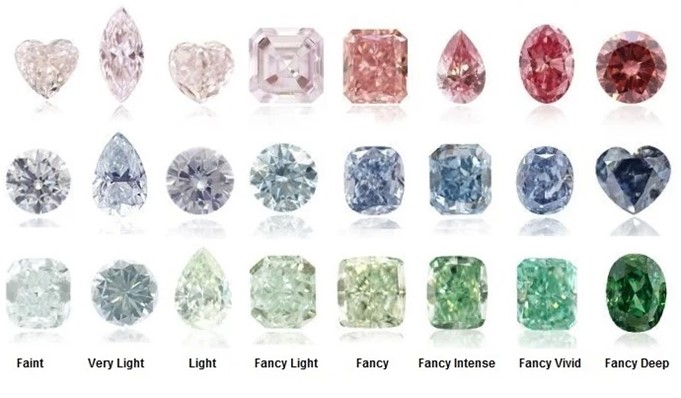
3. Clarity
The clarity of a diamond is determined by the amount of inclusions. The smaller and fewer there are, the less likely they will interfere with the passage of light through the diamond. While the industry generally calls these carbon dots inclusions, many jewelers prefer to instead say “characteristics” of a diamond since these can be used to identify them. Diamonds, more than any other gemstone, have the capability to produce the maximum amount of brilliance. And while these are characteristics, it is also true that diamonds free of inclusions and blemishes are very rare and, therefore, more valuable. As with all Cs, clarity is divided into different categories:
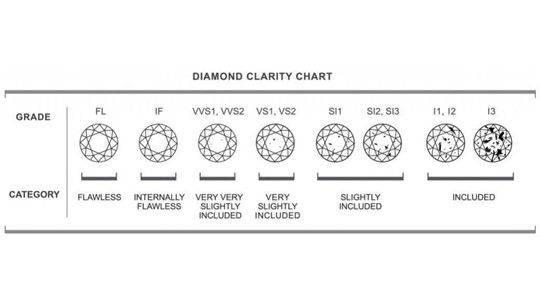
4. Carat-Weight
Many clients often focus too much on carat-weight when really bigger is bigger and not necessarily better! One carat is divided into 100 “points,” so that a diamond of 75 points weighs .75 carats. Carat-weight is the easiest of the 4Cs to determine. Important to highlight is that two diamonds of equal carat-weight can have very unequal value depending on their cut, clarity, and color. Fine quality can be found in diamonds of all shapes and sizes.
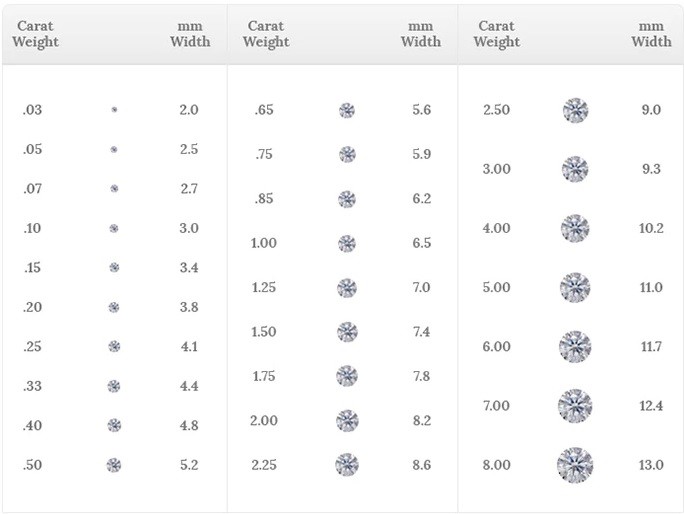
Design of the diamond also plays a factor in its weight and visual effect. Weight ratio is the diamond’s weight in relation to its average girdle diameter (a fairly complex mathematical equation). A girdle, as a reminder, separates the crown of a diamond from the pavilion. A diamond with a smaller girdle diameter relative to its weight might appear smaller face-up than its well-designed counterpart, because much of the weight would be “hidden” in the overall depth of the diamond. For example, while a diamond with a thicker girdle could look great, the girdle is hiding unnecessary weight. As a result, you might end up paying more for a heavier diamond with no greater visual impact for the added cost. As a tip, a diamond should not weigh more than its face-up size would indicate.

Final Notes
While the 4 Cs are the main characteristics of a diamond, there are many other subcategories that can become an important factor for a client when choosing their ideal diamond. When shopping for a diamond, it is up to the client to determine what their preference is. Some might prefer an impeccable brilliance over carat-size. Others might compromise clarity over a larger diamond to reduce cost. The shape of a diamond can also play to the illusion of its size. Elongated shapes like pear, emerald, and marquis can make the gem look larger. The great part is there are a myriad of brands, suppliers, and diamond types to choose from to fulfill your desire!
¡Salud y Éxito!
Daniela Barquet
Daniela Barquet is the 4th generation owner of her family's jewelry store located in Old San Juan, Puerto Rico since 1965. The business tradition was started by her great-grandfather, Issac Barquet, in 1920. Daniela graduated from Boston University with a Bachelor's in the History of Art and Architecture and a Minor in Italian Studies. Daniela continues to grow under the mentorship of her father, Natalio Barquet Perez, who is a renowned, certified jeweler in Puerto Rico.

